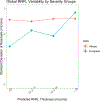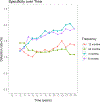Frequency of Optical Coherence Tomography Testing to Detect Progression in Glaucoma
- PMID: 35980865
- PMCID: PMC9633358
- DOI: 10.1097/IJG.0000000000002101
Frequency of Optical Coherence Tomography Testing to Detect Progression in Glaucoma
Abstract
Prcis: With high specificity and less variability than perimetry, more frequent testing resulted in shorter time to detect progression, though a 6-month testing interval provides a reasonable trade-off for following glaucoma patients using optical coherence tomography (OCT).
Purpose: To investigate the time to detect progression in glaucomatous eyes using different OCT test intervals.
Materials and methods: Participants with manifest glaucoma from the African Descent and Glaucoma Evaluation Study (ADAGES), a multicenter, prospective, observational cohort study, were included. A total of 2699 OCT tests from 171 glaucomatous and 149 normal eyes of 182 participants, with at least 5 tests and 2 years of follow-up, were analyzed. Computer simulations (n=10,000 eyes) were performed to estimate time to detect progression of global circumpapillary retinal nerve fiber layer thickness (cpRNFL) measured with OCT tests. Simulations were based on different testing paradigms (every 4, 6, 12, and 24 mo) and different rates of change (µm/year). Time to detect significant progression ( P <0.05) at 80% and 90% power were calculated for each paradigm and rate of cpRNFL change.
Results: As expected, more frequent testing resulted in shorter time to detect progression. Although there was clear disadvantage for testing at intervals of 24 versus 12 months (~22.4% time [25 mo] increase in time to progression detection) and when testing 12 versus 6 months (~22.1% time [20 mo] increase), the improved time to detect progression was less pronounced when comparing 6 versus 4 months (~11.5% time [10 mo] reduction).
Conclusion: With high specificity and less variability than perimetry, a 6-month testing interval provides a reasonable trade-off for following glaucoma patients using OCT.
Copyright © 2022 Wolters Kluwer Health, Inc. All rights reserved.
Conflict of interest statement
Disclosure: The authors declare no conflict of interest.
Figures




